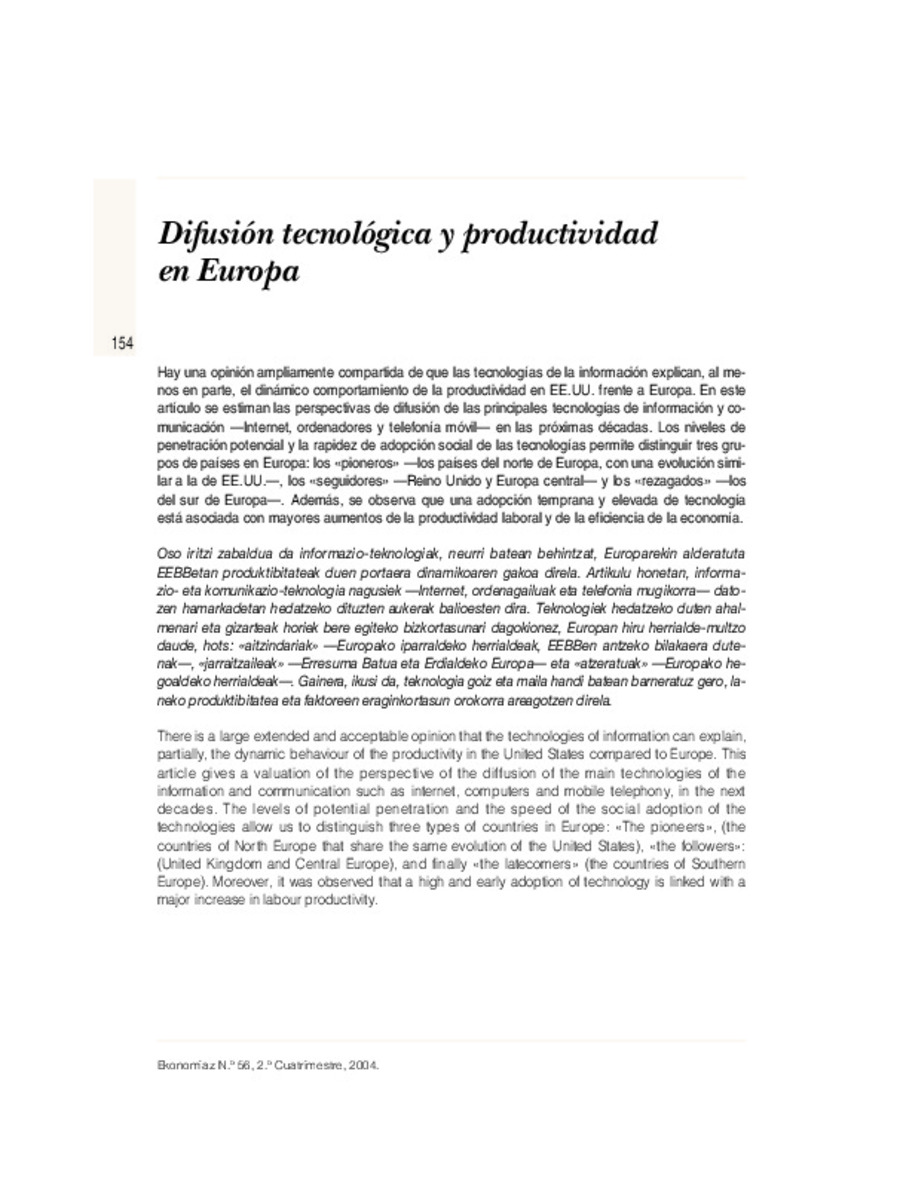Mostrar el registro sencillo del ítem
Difusión tecnológica y productividad en Europa.
| dc.contributor.author | Balmaseda del Campo, Manuel | |
| dc.contributor.author | Melguizo Esteso, Ángel | |
| dc.date.accessioned | 2015-07-23T12:32:11Z | |
| dc.date.available | 2015-07-23T12:32:11Z | |
| dc.date.issued | 2004 | |
| dc.identifier.issn | 0213-3865 | |
| dc.identifier.uri | http://hdl.handle.net/10234/128870 | |
| dc.description.abstract | Hay una opinión ampliamente compartida de que las tecnologías de la información explican, al menos en parte, el dinámico comportamiento de la productividad en EE.UU. frente a Europa. En este artículo se estiman las perspectivas de difusión de las principales tecnologías de información y comunicación 'Internet, ordenadores y telefonía móvil' en las próximas décadas. Los niveles de penetración potencial y la rapidez de adopción social de las tecnologías permite distinguir tres grupos de países en Europa: los «pioneros» 'los países del norte de Europa, con una evolución similar a la de EE.UU.', los «seguidores» 'Reino Unido y Europa central' y los «rezagados» 'los del sur de Europa'. Además, se observa que una adopción temprana y elevada de tecnología está asociada con mayores aumentos de la productividad laboral y de la eficiencia de la economía. | ca_CA |
| dc.description.abstract | There is a large extended and acceptable opinion that the technologies of information can explain, partially, the dynamic behaviour of the productivity in the United States compared to Europe. This article gives a valuation of the perspective of the diffusion of the main technologies of the information and communication such as internet, computers and mobile telephony, in the next decades. The levels of potential penetration and the speed of the social adoption of the technologies allow us to distinguish three types of countries in Europe: «The pioneers», (the countries of North Europe that share the same evolution of the United States), «the followers»: (United Kingdom and Central Europe), and finally «the latecomers» (the countries of Southern Europe). Moreover, it was observed that a high and early adoption of technology is linked with a major increase in labour productivity. | ca_CA |
| dc.format.extent | 24 p. | ca_CA |
| dc.format.mimetype | application/pdf | ca_CA |
| dc.language.iso | spa | ca_CA |
| dc.publisher | Gobierno Vasco: Departamento de Hacienda y Administración Pública = Ogasun eta Herri Administrazio Saila | ca_CA |
| dc.relation.isPartOf | Ekonomiaz: Revista vasca de economía, 2004, Nº 56, p.154-177. | ca_CA |
| dc.rights | Attribution-NonCommercial-NoDerivs 3.0 Spain | * |
| dc.rights.uri | http://creativecommons.org/licenses/by-nc-nd/4.0/ | * |
| dc.title | Difusión tecnológica y productividad en Europa. | ca_CA |
| dc.type | info:eu-repo/semantics/article | ca_CA |
| dc.rights.accessRights | info:eu-repo/semantics/openAccess | ca_CA |
| dc.subject.eurovoc | Productividad | ca_CA |
| dc.subject.eurovoc | Productivity | ca_CA |
| dc.subject.eurovoc | Tecnología de la información | ca_CA |
| dc.subject.eurovoc | Information technology | ca_CA |
| dc.subject.eurovoc | Nueva tecnología | ca_CA |
| dc.subject.eurovoc | New technology | ca_CA |
| dc.subject.eurovoc | Europa | ca_CA |
| dc.subject.eurovoc | Europe | ca_CA |
| dc.subject.eurovoc | Estados Unidos | ca_CA |
| dc.subject.eurovoc | United States | ca_CA |








